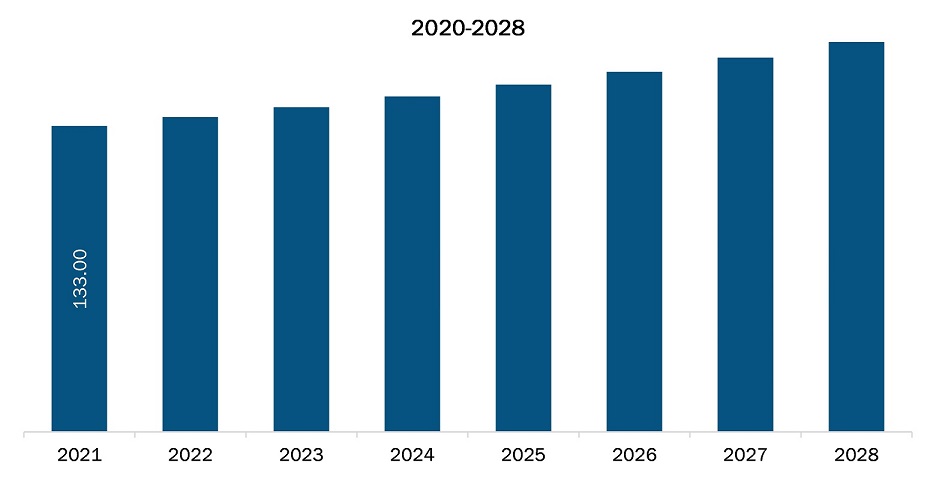The South and Central America colonoscopes market is expected to reach US$ 169.50 million by 2028 from US$ 136.89 million in 2021; it is estimated to grow at a CAGR of 3.5% from 2021 to 2028. A few factors such as the increasing prevalence of colorectal cancer, growing research activities to extend its applications in therapeutic areas, technological advancements in colonoscopy devices, and development of robotic colonoscopes are driving the growth of the colonoscopes market. However, the availability of alternative diagnostic tests for rectal diseases hampers the market growth.
Colorectal cancer is a malignant tumor that develops in the tissues of colon or rectum. Colon and rectal cancer are often grouped due to common features of both conditions. According to an article published online by science direct, in 2016, colorectal cancer is one the 5 the leading cancer diagnosis in Central and South America and males have 1–2 times higher colorectal cancer rates than females. Furthermore, it is the second leading cause of cancer death in the country, among men and women combined, while it stands as the third leading cause of cancer death when men and women are considered separately. Such a high prevalence makes it the second most frequently occurring cancer, after breast cancer, and the second leading cause of death, after lung cancer. In ideal situations, where the cancer is diagnosed in early stages, doctors can remove the tumor via surgical procedures. A colonoscopy is an important screening test for colorectal cancer, and it has become a part of routine cancer screening. The annual count of adults getting screened for cancer surged by 3.3 million in the US during 2014–2016, which is considered a prime factor associated with a 30% decrease in colon cancer mortality rate in people older than 50 in the past decade. In its updated screening guidelines released in 2018, the American Cancer Society quoted colonoscopies as the gold standard for detecting cancers and precancerous polyps in the colon. Also, to significantly reduce the adenoma “miss rate” of standard forward-viewing colonoscopy, manufacturers across globe are continuously striving to improve the current colonoscopy techniques, by exploring more advanced optics and wider-angle visualization tools along with a user-friendly, intuitive endoscopic platform interface. The introduction of such technologies is fuelling the colonoscope market growth.
The COVID-19 pandemic has severely impacted medical care in South and Central America. Market participants and end users are losing their businesses due to the temporary closure of companies in different countries. In this situation, there was the discontinuation of diagnosis and other related treatments. However, the COVID-19 outbreak has had a negative impact on the flow of medical care in the area. The COVID-19 pandemic has shifted the accepted and routine treatment of elective cases in hospital administration. This postponement resulted in a delay in the treatment of all non-COVID-19 patients, including cancer patients. The pandemic can lead to further potential innovations in cancer screening. Colon cancer screening programs (CRC) have been forcibly suspended since the pandemic began. A hospital system in distress needs a systematic approach to ensure timely cancer care. Screening delays beyond 4–6 months would significantly increase advanced CRC cases and mortality if they lasted longer than 12 months.

- This FREE sample will include data analysis, ranging from market trends to estimates and forecasts.
SOUTH AND CENTRAL AMERICA COLONOSCOPES MARKET SEGMENTATION
By Product Type
- Fiber Optic Colonoscopy Devices
- Video Colonoscopy Devices
By Application
- Colorectal Cancer
- Lynch Syndrome
- Ulcerative Colitis
- Crohn's Disease
- Polyp
By End User
- Hospitals
- Ambulatory Surgery Center
- Other End Users
By Country
- Brazil
- Argentina
- Rest of South and Central America
Company Profiles
- Fujifilm Corporation
- Olympus Corporation
- KARL STORZ SE & Co. KG
- PENTAX Medical
- Boston Scientific Corporation
- SonoScape Medical Corp.
South and Central America Colonoscopes Report Scope
| Report Attribute | Details |
|---|---|
| Market size in 2021 | US$ 136.89 Million |
| Market Size by 2028 | US$ 169.50 Million |
| CAGR (2021 - 2028) | 3.5% |
| Historical Data | 2019-2020 |
| Forecast period | 2022-2028 |
| Segments Covered |
By Product Type
|
| Regions and Countries Covered |
South and Central America
|
| Market leaders and key company profiles |
|
- Historical Analysis (2 Years), Base Year, Forecast (7 Years) with CAGR
- PEST and SWOT Analysis
- Market Size Value / Volume - Regional, Country
- Industry and Competitive Landscape
- Excel Dataset
Recent Reports
Testimonials
Reason to Buy
- Informed Decision-Making
- Understanding Market Dynamics
- Competitive Analysis
- Identifying Emerging Markets
- Customer Insights
- Market Forecasts
- Risk Mitigation
- Boosting Operational Efficiency
- Strategic Planning
- Investment Justification
- Tracking Industry Innovations
- Aligning with Regulatory Trends





















 Get Free Sample For
Get Free Sample For